Petrogenesis and Metallogenesis of Granitoids in the Yangla Cu-W Polymetallic Deposit, Southwest China: Evidence from Zircon Trace Elements and Hf Isotope
Abstract
1. Introduction
2. Geological Setting
3. Sampling and Analytical Methods
4. Results
4.1. Zircon Trace Elements Compositions
4.2. Hf Isotopic Compositions of Quartz Diorite
4.3. Hf Isotopic Compositions of Other Granitoid Plutons
4.4. Comparison of Yangla Granitoid Plutons
4.4.1. Geochronology
4.4.2. Hf Isotopic Geochemistry
4.5. Crystallization Temperature
4.6. Oxygen Fugacity
5. Discussion
5.1. Magma Source
5.2. Assimilation and Fractional Crystallization
5.2.1. Assimilation
5.2.2. Fractional Crystallization
5.3. Magmatic Evolutionary Sequence
5.4. Metallogenic Potential
6. Conclusions
- The crystallization temperature and oxygen fugacity of the magma show a gradually increased and decreased from dioritic enclaves and granodiorite through quartz monzonite porphyry and to quartz diorite in the Yangla mining district, respectively.
- Yangla granodiorite, dioritic enclaves, quartz monzonite porphyry, and quartz diorite have consistent magma sources, all of which originate from three-component upper crust + lower crust + mantle mixed magmas; the provenance is primarily Proterozoic basement components and a small quantity of mantle-derived materials.
- The degree of crustal metasediments assimilation and differentiation have gradually increased from dioritic enclaves and granodiorite through quartz monzonite porphyry and to quartz diorite. These granitoids plutons mainly experienced the separation and crystallization of apatite, titanite, and hornblende.
- Yangla granodiorite and dioritic enclaves, quartz monzonite porphyry, and quartz diorite were formed in the early, mid, and late stages of magmatic evolution, respectively.
- Yangla granitoids plutons have a better potential for Cu-W polymetallic deposits.
Supplementary Materials
Author Contributions
Funding
Data Availability Statement
Acknowledgments
Conflicts of Interest
References
- Li, B.; Wang, X.F.; Tang, G.; Liu, Y.D.; Zou, G.F. S-Pb isotopes and tectono-geochemistry of the Lunong ore block, Yangla large Cu deposit, SW China: Implications for mineral exploration. Ore Geol. Rev. 2021, 136, 104249. [Google Scholar] [CrossRef]
- Zhu, J.J.; Hu, R.Z.; Bi, X.W.; Zhong, H.; Chen, H. Zircon U-Pb ages, Hf-O isotopes and whole-rock Sr-Nd-Pb isotopic geochemistry of granitoids in the Jinshajiang suture zone, SW China: Constraints on petrogenesis and tectonic evolution of the Paleo-Tethys Ocean. Lithos 2011, 126, 248–264. [Google Scholar] [CrossRef]
- Meng, X.Y.; Mao, J.W.; Zhang, C.Q.; Zhang, D.Y.; Kong, Z.G.; Jia, F.D. The timing, origin and T-fO2 crystallization conditions of long-lived magmatism at the Yangla copper deposit, Sanjiang Tethyan orogenic belt: Implications for post-collisional magmatic-hydrothermal ore formation. Gondwana Res. 2016, 40, 211–229. [Google Scholar] [CrossRef]
- Wang, Y.B.; Han, J.; Zeng, P.S.; Wang, D.H.; Hou, K.J.; Yin, G.H.; Li, W.C. U-Pb dating and Hf isotopic characteristics of zircons from granodiorite in Yangla copper deposit, Deqin County, Yunnan, Southwest China. Acta Petrol. Sin. 2010, 26, 1833–1844, (In Chinese with English abstract). [Google Scholar]
- Zhang, H.R.; Yang, L.Q.; He, W.Y.; Gao, X.; Wang, H.Q.; Zhang, S.Y. Geochronology and geochemistry of the Tongjige granodiorites in the Jinshajiang suture zone, SW China: Constraints on petrogenesis and tectonic evolution of the Palaeo-Tethys Ocean. Geol. J. 2021, 56, 1445–1463. [Google Scholar] [CrossRef]
- Yang, F.; Yu, C.; Jian, R.T.; Yao, Z.H. Characteristics of Petrology, Geochemistry and U-Pb Dating of Zircon from the Jiangbian Pluton in the Yangla Copper Deposit, Western Yunnan. Geoscience 2020, 34, 215–232, (In Chinese with English abstract). [Google Scholar]
- Chen, S.Y.; Gu, X.X.; Cheng, W.B.; Zhang, Y.M.; Zheng, L.; Peng, Y.W.; Liu, R.P. Characteristics of stable isotopic compositions and its geological significances of the Yangla copper deposit, northwestern Yunnan Province. Acta Petrol. Sin. 2013, 29, 1290–1300, (In Chinese with English abstract). [Google Scholar]
- Zhu, J.J.; Hu, R.Z.; Richards, J.P.; Bi, X.W.; Zhong, H. Genesis and Magmatic-Hydrothermal Evolution of the Yangla Skarn Cu Deposit, Southwest China. Econ. Geol. 2015, 110, 631–652. [Google Scholar] [CrossRef]
- Du, L.J.; Li, B.; Huang, Z.L.; Zhou, J.X.; Zou, G.F.; Yan, Z.F. Carbon-oxygen isotopic geochemistry of the Yangla Cu skarn deposit, SW China: Implications for the source and evolution of hydrothermal fluids. Ore Geol. Rev. 2017, 88, 809–821. [Google Scholar] [CrossRef]
- Yang, X.A.; Liu, J.J.; Han, S.Y.; Zhang, H.Y.; Luo, C.; Wang, H.; Chen, S.Y. U-Pb dating of zircon from the Linong granodiorite, Re-Os dating of molybdenite from the ore body and their geological significances in Yangla copper deposit, Yunnan. Acta Petrol. Sin. 2011, 27, 2567–2576, (In Chinese with English abstract). [Google Scholar]
- Xie, S.X.; Yang, L.Q.; He, W.Y.; Gao, X. Garnet trace element geochemistry of Yangla Cu deposit in NW Yunnan, China: Implications for multistage ore-fluid activities in skarn system. Ore Geol. Rev. 2022, 141, 104662. [Google Scholar] [CrossRef]
- Wang, X.F.; Li, B.; Xiang, Z.P.; Yue, Y.; Tang, G. Chemical compositions of sulfides in the porphyry Cu ores, Yangla Cu deposit, Yunnan, China: Implication for ore genesis. Acta Geochim. 2020, 39, 947–972. [Google Scholar] [CrossRef]
- Wang, X.F.; Li, B.; Guan, S.J.; Nadeau, O.; Tang, G. Mineralized Granitic Porphyry of the Yangla Copper Deposit, Western Yunnan, China: Geochemistry of Fluid Inclusions and H-O, S, and Pb isotopes. Geofluids 2020, 2020, 4391703. [Google Scholar] [CrossRef]
- Li, B.; Wang, X.F.; Du, L.J.; Xiang, Z.P.; Tang, G.; Huang, Z.L. Zircon U-Pb ages and geochemistry of granite porphyries in the Yangla Cu deposit, SW China: Constraints on petrogenesis and tectonic evolution of the Jinshajiang suture belt. Geofluids 2020, 2020, 8852277. [Google Scholar] [CrossRef]
- Wu, F.Y.; Li, X.H.; Zheng, Y.F.; Gao, S. 2007 Lu-Hf isotopic systematics and their applications in petrology. Acta Petrol. Sin. 2007, 23, 185–220, (In Chinese with English abstract). [Google Scholar]
- Li, H.; Danišík, M.; Zhou, Z.K.; Jiang, W.C.; Wu, J.H. Integrated U–Pb, Lu–Hf and (U–Th)/He analysis of zircon from the Banxi Sb deposit and its implications for the low-temperature mineralization in South China. Geosci. Front. 2020, 11, 1323–1335. [Google Scholar] [CrossRef]
- Hoskin, P.W.O.; Ireland, T.R. Rare earth element chemistry of zircon and its use as a provenance indicator. Geology 2000, 28, 627–630. [Google Scholar] [CrossRef]
- Hanchar, J.M.; Westrenen, W.V. Rare Earth Element Behavior in Zircon-Melt Systems. Elements 2007, 3, 37–42. [Google Scholar] [CrossRef]
- Ballard, J.R.; Palin, M.J.; Campbell, I.H. Relative oxidation states of magmas inferred from Ce(IV)/Ce(III) in Zircon: Application to porphyry copper deposits of Northern Chile. Contrib. Mineral. Petrol. 2002, 144, 347–364. [Google Scholar] [CrossRef]
- Nardi, L.; Formoso, M.; Jarvis, K.; Oliveira, L.; Neto, A.; Fontana, E. REE, Y, Nb, U, and Th contents and tetrad effect in zircon from a magmatic-hydrothermal F-rich system of Sn-rare metal–cryolite mineralized granites from the Pitinga Mine, Amazonia, Brazil. J. S. Am. Earth Sci. 2012, 3, 34–42. [Google Scholar] [CrossRef]
- Dilles, J.H.; Kent, A.J.R.; Wooden, J.L.; Tosdal, R.M.; Koleszar, A.K.; Lee, R.G.; Farmer, L.P. Zircon compositional evidence for sulfur-degassing from ore-forming arc magmas. Econ. Geol. 2015, 110, 241–251. [Google Scholar] [CrossRef]
- Lu, Y.J.; Loucks, R.T.; Fiorentini, M.; Mccuaig, T.C.; Evans, N.J.; Yang, Z.M.; Hou, Z.Q.; Kirkland, C.L.; Parra-Avila, L.A.; Kobussen, A. Zircon compositions as a pathfinder for porphyry Cu ± Mo ± Au deposits. Soc. Econ. Geol. Spec. Publ. 2016, 19, 329–347. [Google Scholar]
- Loader, M.A.; Wilkinson, J.J.; Armstrong, R.N. The effect of titanite crystallisation on Eu and Ce anomalies in zircon and its implications for the assessment of porphyry Cu deposit fertility. Earth Planet. Sci. Lett. 2017, 472, 107–119. [Google Scholar] [CrossRef]
- Yuan, F.; Liu, J.J.; Carranza, E.J.M.; Zhai, D.G.; Wang, Y.H.; Zhang, S.; Sha, Y.Z.; Liu, G.; Wu, J. The Guangshigou uranium deposit, northern Qinling Orogen, China: A product of assimilation-fractional crystallization of pegmatitic magma. Ore Geol. Rev. 2018, 99, 17–41. [Google Scholar] [CrossRef]
- Lee, R.G.; Byrne, K.; D’Angelo, M.; Hart, C.J.R.; Hollings, P.; Gleeson, S.A.; Alfaro, M. sing zircon trace element composition to assess porphyry copper potential of the Guichon Creek batholith and Highland Valley Copper deposit, south-central British Columbia. Miner. Depos. 2021, 56, 215–238. [Google Scholar] [CrossRef]
- Li, H.; Cao, J.; Algeo, T.J.; Jiang, W.; Liu, B.; Wu, Q. Zircons reveal multi-stage genesis of the Xiangdong (Dengfuxian) tungsten deposit, South China. Ore Geol. Rev. 2019, 111, 102979. [Google Scholar] [CrossRef]
- Wang, L.G.; Li, X.Z.; Yu, X.W.; Zhu, D.C.; Wang, Y.P.; Zhang, W.; Ke, C.H.; Hu, Z.G.; Guo, R.P.; Hao, X.Z. Petrogenesis and tectonic setting of Dazeshan and Tianzhushan granites in Jiaodong peninsula: Geochemistry, zircon U-Pb geochronology and Lu-Hf isotopic constraints. J. Jilin Univ. 2022, 52, 879–898, (In Chinese with English abstract). [Google Scholar]
- Liu, X.L.; Li, W.C. The Indo-Chinese epoch magmatism in Gega arc of Yunnan: Evidence from zircon U-Pb dating and Hf isotopic composition. Earth Sci. Front. 2013, 20, 57–74, (In Chinese with English abstract). [Google Scholar]
- Duan, S.S.; Dong, Y.; Wang, W.Z.; Guo, L. Geochronology, geochemistry and Hf isotopic characteristics of Early Cretaceous A-Type granite in Erdene area, southern Mongolia and their geological significance. J. Jilin Univ. 2022, 52, 917–929, (In Chinese with English abstract). [Google Scholar]
- Deng, J.; Wang, Q.F.; Li, G.J.; Li, C.S.; Wang, C.M. Tethys tectonic evolution and its bearing on the distribution of important mineral deposits in the Sanjiang region, SW China. Gondwana Res. 2014, 26, 419–437. [Google Scholar] [CrossRef]
- Li, B.; Wang, X.F.; Yue, Y.; Huang, Z.L.; Tang, G.; Liu, Y.D.; Zou, G.F.; Xiang, Z.P. Ore-field structural system and its mechanism of rock-and ore-controlling processes of Yangla Cu deposit in northwest Yunnan, China. Chin. J. Nonferrous Met. 2021, 31, 2596–2611, (In Chinese with English abstract). [Google Scholar]
- Li, B.; Zou, G.F.; Wen, S.M.; Huang, Z.L.; Tang, G.; Liu, Y.D.; Sheng, R. Fault structure, ore-controlling structural model and prospecting prediction of Yangla copper deposit, northwestern Yunnan. Miner. Explor. 2014, 5, 699–711, (In Chinese with English abstract). [Google Scholar]
- Chen, K.X.; Wei, J.Q.; Yan, D.P.; Fan, Y.H. A preliminary study of porphyry bodies and related mineralizaton in Yangla area, Deqing, western Yunnan. Geol. Miner. Resour. S. China 1999, 2, 1–81, (In Chinese with English abstract). [Google Scholar]
- Lu, Y.F.; Zhan, M.G.; Chen, K.X. U-Pb isotopic dating of basalt from the Gajinxueshan Group in the Jinshajiang tectonic belt. Reg. Geol. China 2000, 19, 155–158, (In Chinese with English abstract). [Google Scholar]
- Zeng, P.S.; Wang, Y.B.; Ma, J.; Wang, Z.Q.; Wen, L.G. Diachronous collision-closure of the Jinshajiang paleo-ocean basin in the Yangla area: Constraints from the ages of the granites. Earth Sci. Front. 2018, 25, 92–105, (In Chinese with English abstract). [Google Scholar]
- Wu, Y.B.; Zheng, Y.F.; Gong, B.; Tang, J.; Zhao, Z.F.; Zha, X.P. Zircon U-Pb ages and oxygen isotope compositions of the Luzhenguan magmatic complex in the Beihuaiyang zone. Acta Petrol. Sin. 2004, 20, 1007–1024, (In Chinese with English abstract). [Google Scholar]
- Williams, I.S.; Claesson, S. Isotopic evidence for the Precambrian provenance and Cale-donian metamorphism of high grade paragneisses from the Seve Nappes, Scandi-navian Caledonides. Contrib. Mineral. Petrol. 1987, 97, 196–204. [Google Scholar] [CrossRef]
- Yuan, H.L.; Gao, S.; Liu, X.M.; Li, H.M.; Günther, D.; Wu, F.Y. Accurate U-Pb age and trace element determinations of zircon by laser ablation-inductively coupled plasma-mass spectrometry. Geostand. Geoanalytical Res. 2010, 28, 353–370. [Google Scholar] [CrossRef]
- Jackson, S.E.; Pearson, N.J.; Griffin, W.L.; Belousova, W.A. The application of laser ablation-inductively coupled plasma-mass spectrometry to in situ U-Pb zircon geochronology. Chem. Geol. 2004, 211, 47–69. [Google Scholar] [CrossRef]
- Li, X.H.; Long, W.G.; Li, Q.L.; Liu, Y.; Zheng, Y.F.; Yang, Y.H.; Chamberlain, K.R.; Wan, D.F.; Guo, C.H.; Wang, X.C.; et al. 2010 Penglai zircon megacrysts: A potential new working reference material for microbeam determination of Hf-O isotopes and U-Pb age. Geostand. Geoanalytical Res. 2010, 34, 117–134. [Google Scholar] [CrossRef]
- Li, X.H.; Tang, G.Q.; Gong, B.; Yang, Y.H.; Hou, K.J.; Hu, Z.C.; Li, Q.L.; Liu, Y.; Li, W.X. Qinghu zircon: A working reference for microbeam analysis of U-Pb age and Hf and O isotopes. Chin. Sci. Bull. 2013, 58, 1954–1961. [Google Scholar] [CrossRef]
- Sláma, J.; Košler, J.; Condon, D.J.; Crowley, J.L.; Gerdes, A.; Hanchar, J.M.; Horstwood, M.S.A.; Morris, G.A.; Nasdala, L.; Norberg, N.; et al. Pleovice zircon—A new natural reference material for U-Pb and Hf isotopic microanalysis. Chem. Geol. 2008, 249, 1–35. [Google Scholar] [CrossRef]
- Münker, C.; Weyer, S.; Scherer, E.; Mezger, K. Separation of high field strength elements (Nb, Ta, Zr, Hf) and Lu from rock samples for MC-ICPMS measurements. Geochem. Geophys. Geosystems 2001, 2. [Google Scholar] [CrossRef]
- Amelin, Y.; Lee, D.C.; Halliday, A.N.; Pidgeon, R.T. Nature of the Earth’s earliest crust from hafnium isotopes in single detrital zircons. Nature 1999, 399, 252–255. [Google Scholar] [CrossRef]
- Griffin, W.L.; Pearson, N.J.; Belousova, E.; Jackson, S.E.; Achterbergh, E.V.; O’reilly, S.Y.; Shee, S.R. The Hf isotope composition of cratonic mantle: LAM-MC-ICPMS analysis of zircon megacrysts in kimberlites. Geochim. Cosmochim. Acta 2000, 64, 133–147. [Google Scholar] [CrossRef]
- Griffin, W.; Wang, X.; Jackson, S.E.; Pearson, N.J.; O’Reilly, S.Y.; Xu, X.S.; Zhou, X.M. Zircon chemistry and magma mixing, SE China: In-situ analysis of Hf isotopes, Tonglu and Pingtan igneous complexes. Lithos 2002, 61, 237–269. [Google Scholar] [CrossRef]
- Hoskin, P.W.O. Trace-element composition of hydrothermal zircon and the alteration of hadean zircon from the Jack Hills, Australia. Geochim. Cosmochim. Acta 2005, 69, 637–648. [Google Scholar] [CrossRef]
- Hoskin, P.W.O.; Schaltegger, U. The composition of zircon and igneous and metamorphic petrogenesis. Petrogenesis 2003, 53, 27–62. [Google Scholar]
- Viala, M.; Hattori, K. Hualgayoc mining district, northern Peru: Testing the use of zircon composition in exploration for porphyry-type deposits. J. Geochem. Explor. 2021, 223, 106725. [Google Scholar] [CrossRef]
- Xia, Q.; Li, Y.S.; Li, X.F.; Kou, Y.C. Zircon U-Pb ages, trace elements and Hf isotopes of the mineralized granodiorite dikes in the Anfangba gold deposit, west Qinling. Acta Petrol. Sin. 2021, 37, 1713–1730, (In Chinese with English abstract). [Google Scholar]
- Li, H.; Watanabe, K.; Yonezu, K. Zircon morphology, geochronology and trace element geochemistry of the granites from the Huangshaping polymetallic deposit, South China: Implications for the magmatic evolution and mineralization processes. Ore Geol. Rev. 2014, 60, 14–35. [Google Scholar] [CrossRef]
- Rubatto, D. Zircon trace element geochemistry: Partitioning with garnet and the link between U–Pb ages and metamorphism. Chem. Geol. 2002, 184, 123–138. [Google Scholar] [CrossRef]
- Sun, S.S.; Mcdonough, W.F. Chemical and isotope systematics of oceanic basalts: Implications for mantle composition and processes. Geol. Soc. Spec. Publ. 1989, 4, 313–345. [Google Scholar] [CrossRef]
- Amelin, Y.; Lee, D.C.; Halliday, A.N. Early-middle archaean crustal evolution deduced from Lu-Hf and U-Pb isotopic studies of single zircon grains. Geochim. Cosmochim. Acta 2000, 64, 4205–4225. [Google Scholar] [CrossRef]
- Vervoort, J.D.; Patchett, P.J.; Gehrels, G.E.; Nutman, A.P. Constraints on early Earth differentiation from hafnium and neodymium isotopes. Nature 1996, 379, 624–627. [Google Scholar] [CrossRef]
- Blichert-Toft, J.; Albarede, F. The Lu-Hf isotope geochemistry of chondrites and the evolution of the mantle-crust system. Earth Planet. Sci. Lett. 1997, 148, 243–258. [Google Scholar] [CrossRef]
- Zhu, Y.H.; Xu, D.R.; Zhang, J.W.; He, M.L.; Chen, G.W.; Shan, Q.; Wang, Z.L. Geochronology and Source Characteristics of the Shimenshan Molybdenum Polymetallic Deposit in Hainan Island and Its Implications for Mineralization by Magmatic Oxygen Fugacity. Geotecton. Metallog. 2022. [Google Scholar] [CrossRef]
- Watson, E.B.; Harrison, T.M. Zircon saturation revisited: Temperature and composition effects in a variety of crustal magma types. Earth Planet. Sci. Lett. 1983, 64, 295–304. [Google Scholar] [CrossRef]
- Watson, E.B.; Wark, D.A.; Thomas, J.B. Crystallization thermometers for zircon and rutile. Contrib. Mineral. Petrol. 2006, 151, 413. [Google Scholar] [CrossRef]
- Ferry, J.M.; Watson, E.B. New thermodynamic models and revised calibrations for the Ti-in-zircon and Zr-in-rutile thermometers. Contrib. Mineral. Petrol. 2007, 154, 429–437. [Google Scholar] [CrossRef]
- Hayden, L.A.; Watson, E.B. Rutile saturation in hydrous siliceous melts and its bearing on Ti-thermometry of quartz and zircon. Earth Planet. Sci. Lett. 2007, 258, 561–568. [Google Scholar] [CrossRef]
- Zou, X.Y.; Qin, K.Z.; Han, X.L.; Li, G.M.; Evans, N.J.; Li, Z.Z.; Yang, W. Insight into zircon REE oxy-barometers: A lattice strain model perspective. Earth Planet. Sci. Lett. 2019, 506, 87–96. [Google Scholar] [CrossRef]
- Trail, D.; Watson, E.B.; Tailby, N.D. Ce and Eu anomalies in zircon as proxies for the oxidation state of magmas. Geochim. Cosmochim. Acta 2012, 97, 70–87. [Google Scholar] [CrossRef]
- Chelle-Michou, C.; Chiaradia, M.; Ovtcharova, M.; Ulianov, A.; Wotzlaw, J.F. Zircon petrochronology reveals the temporal link between porphyry systems and the magmatic evolution of their hidden plutonic roots (the Eocene Coroccohuayco Deposit, Peru). Lithos 2014, 198–199, 129–140. [Google Scholar] [CrossRef]
- Smythe, D.J.; Brenan, J.M. Magmatic oxygen fugacity estimated using zirconmelt partitioning of cerium. Earth Planet. Sci. Lett. 2016, 453, 260–266. [Google Scholar] [CrossRef]
- Zhang, C.C.; Sun, W.D.; Wang, J.T.; Zhang, L.P.; Sun, S.J.; Wu, K. Oxygen fugacity and porphyry mineralization: A zircon perspective of Dexing porphyry Cu deposit, China. Geochim. Cosmochim. Acta 2017, 206, 343–363. [Google Scholar] [CrossRef]
- Li, S.K.; Liu, X.L.; Lv, Y.X.; Zhang, S.T.; Liu, S.H.; Chen, J.H.; Li, Z.H.; Yu, H.J.; Zhang, C.Y. Indication of Zircon oxygen fugacity to different mineralization control factors of porphyry deposits in Zhongdian ore-concentrated area, southern Yidun arc. Earth Sci. 2022, 47, 1435–1458, (In Chinese with English abstract). [Google Scholar]
- Loucks, R.R.; Fiorentini, M.L.; Henríquez, G.J. New magmatic oxybarometer using trace elements in zircon. J. Petrol. 2020, 61, egaa034. [Google Scholar] [CrossRef]
- Xu, M.; Duan, X.X.; Chen, B.; Wang, Z.Q.; Chen, Y.J.; Li, X.F. Trace elements in zircon: Constrain on magmatic differentiation-A case study on Triassic Wangxianling granitoid in southern Hunan Province. Geol. Rev. 2020, 66, 665–685, (In Chinese with English abstract). [Google Scholar]
- Xiong, X.; Zhu, L.M.; Zhang, G.W.; Li, N.; Yuan, H.L.; Ding, L.L.; Sun, C.; Guo, A.L. Fluid inclusion geochemistry and magmatic oxygen fugacity of the Wenquan Triassic molybdenum deposit in the Western Qinling Orogen, China. Ore Geol. Rev. 2018, 99, 244–263. [Google Scholar] [CrossRef]
- Li, H.; Wu, J.H.; Evans, N.J.; Jiang, W.C.; Zhou, Z.K. Zircon geochronology and geochemistry of the Xianghualing A-type granitic rocks: Insights into multi-stage Sn-polymetallic mineralization in South China. Lithos 2018, 312–313, 1–20. [Google Scholar] [CrossRef]
- Li, H.; Li, J.W.; Algeo, T.J.; Wu, J.H.; Cisse, M. Zircon indicators of fluid sources and ore genesis in a multi-stage hydrothermal system: The Dongping Au deposit in North China. Lithos 2018, 314–315, 463–478. [Google Scholar] [CrossRef]
- Ye, L.X.; Zhang, D.Y.; Wang, F.Y.; Jiang, Z.R.; Chen, X.F.; Zhang, F.; Xi, X.C.; Zhou, T.F. Magmatic genesis and mineralization potential of Qingyang—Jiuhuashan complex pluton: Evidence from zircon Hf isotopes and trace elements. Geol. Rev. 2022, 68, 1278–1300, (In Chinese with English abstract). [Google Scholar]
- Bolhar, R.; Weaver, S.D.; Whitehouse, M.J.; Palin, J.M.; Woodhead, J.D.; Cole, J.W. Sources and evolution of arc magmas inferred from coupled O and Hf isotope systematics of plutonic zircons from the Cretaceous Separation Point Suite (New Zealand). Earth Planet. Sci. Lett. 2008, 268, 312–324. [Google Scholar] [CrossRef]
- Wang, L.G.; Zhu, D.C.; Guo, R.M.; Yu, X.W.; Tian, J.X.; Ke, C.H.; Liu, H.D.; Tian, R.C.; Gao, H.L. Geochemistry, zircon U-Pb age and Lu-Hf isotopes of the Cangshang and Sanshandao monzogranites in the Northwestern Jiaodong Peninsula, China. Acta Geol. Sin. 2018, 92, 2081–2095, (In Chinese with English abstract). [Google Scholar]
- Hou, M.L.; Jiang, Y.H.; Jiang, S.Y.; Ling, H.F.; Zhao, K.D. Contrasting origins of late Mesozoic adakitic granitoids from the northwestern Jiaodong Peninsula, east China: Implications for crustal thickening to delamination. Geol. Mag. 2007, 144, 619–631. [Google Scholar] [CrossRef]
- Kemp, A.I.S.; Hawkesworth, C.J.; Foster, G.L.; Paterson, B.A.; Woodhead, J.D.; Hergt, J.M.; Gray, C.M.; Whitehouse, M.J. Magmatic and crustal differentiation history of granitic rocks from Hf-O isotopes in zircon. Science 2007, 315, 980–983. [Google Scholar] [CrossRef]
- Li, Y.J.; Wei, J.H.; Chen, H.Y.; Li, H.; Chen, C.; Hou, B.J. Petrogenesis of the Xiasai early Cretaceous A-type granite from the Yidun island arc belt, SW China: Constraints from zircon U-Pb age, geochemistry and Hf isotope. Geotecton. Metallog. 2014, 38, 939–953, (In Chinese with English abstract). [Google Scholar]
- Wang, N.; Wu, C.L.; Qin, H.P.; Lei, M.; Guo, W.F.; Zhang, X.; Chen, H.J. Zircon U-Pb geochronology and Hf isotopic characteristic of the Daocheng granite and Haizishan granite in the Yidun Arc, western Sichuan, and their geological significance. Acta Geol. Sin. 2016, 90, 3227–3245, (In Chinese with English abstract). [Google Scholar]
- Zhang, R.G.; Gao, X.; Yang, L.Q. Identification of magma mixing: A case study of the Daocheng batholith in the Yidun Arc. Adv. Earth Sci. 2018, 33, 1058–1074. [Google Scholar]
- Yang, D.T.; Wang, Y.B. Detrital zircon LA-MC-ICP-MS U-Pb age and provenance characteristics of ore-hosting rocks in Yangla copper deposit, Northwestern Yunnan. Geol. Rev. 2013, 59, 1131–1142, (In Chinese with English abstract). [Google Scholar]
- Greentree, M.R.; Li, Z.X.; Li, X.H.; Wu, H.C. Late Mesoproterozoic to earliest Neoproterozoic basin record of the Sibao orogenesis in western South China and relationship to the assembly of Rodinia. Precambrian Res. 2006, 151, 79–100. [Google Scholar] [CrossRef]
- Zhao, X.F.; Zhou, M.F.; Hitzman, M.W. Late paleoproterozoic to early mesoproterozoic tangdan sedimentary rockhosted strata-bound copper deposit, Yunnan Province, Southwest China. Econ. Geol. 2012, 107, 357–375. [Google Scholar] [CrossRef]
- Zhao, J.H.; Zhou, M.F.; Yan, D.P.; Yang, Y.H.; Sun, M. Zircon Lu-Hf isotopic constraints on Neoproterozoic subduction-related crustal growth along the western margin of the Yangtze Block, South China. Precambrian Res. 2008, 163, 189–209. [Google Scholar] [CrossRef]
- Wu, F.Y.; Li, X.H.; Yang, J.H.; Zheng, Y.F. Discussions on the petrogenesis of granites. Acta Petrol. Sin. 2007, 23, 1217–1238, (In Chinese with English abstract). [Google Scholar]
- Li, X.H.; Li, W.X.; Wang, X.C.; Li, Q.L.; Liu, Y.; Tang, G.Q. Role of mantle-derived magma in genesis of early Yanshanian granites in the Nanling Range, South China: In situ zircon Hf-O isotopic constraints. Sci. China Ser. D Earth Sci. 2009, 39, 872–887. [Google Scholar] [CrossRef]
- Bell, E.A.; Kirkpatrick, H.M. Effects of crustal assimilation and magma mixing on zircon trace element relationships across the Peninsular Ranges Batholith. Chem. Geol. 2021, 586, 120616. [Google Scholar] [CrossRef]
- Valley, J. Oxygen isotopes in zircon. Rev. Mineral. Geochem. 2003, 53, 343–385. [Google Scholar] [CrossRef]
- Trail, D.; Tailby, N.D.; Sochko, M.; Ackerson, M.R. Possible biosphere-lithosphere interactions preserved in igneous zircon and implications for Hadean earth. Astrobiology 2015, 15, 575–586. [Google Scholar] [CrossRef]
- Zhu, Z.; Campbell, I.H.; Allen, C.M.; Burnham, A.D. S-type granites: Their origin and distribution through time as determined from detrital zircons. Earth Planet. Sci. Lett. 2020, 536, 116140. [Google Scholar] [CrossRef]
- Bell, E.A.; Boehnke, P.; Barboni, M.; Harrison, T.M. Tracking chemical alteration in magmatic zircon using rare earth element abundances. Chem. Geol. 2019, 510, 56–71. [Google Scholar] [CrossRef]
- Morton, D.M.; Miller, F.K.; Kistler, R.W.; Premo, W.R.; Lee, C.T.A.; Langenheim, V.E.; Cossette, P. Framework and petrogenesis of the northern Peninsular Ranges batholith, southern California. Peninsular Ranges Batholith, Baja California and Southern California. Geol. Soc. Am. Mem. 2014, 211, 61–143. [Google Scholar]
- Kistler, R.W.; Wooden, J.L.; Premo, W.R.; Morton, D.M.; Miller, F.K. Pb–Sr–Nd–O isotopic characterization of Mesozoic rocks throughout the northern end of the Peninsular Ranges batholith: Isotopic evidence for the magmatic evolution of oceanic arc–continental margin accretion during the Late Cretaceous of southern California. Peninsular Ranges Batholith, Baja California and Southern California. Geol. Soc. Am. Mem. 2014, 211, 263–316. [Google Scholar]
- Bruand, E.; Storey, C.; Fowler, M. Accessory mineral chemistry of high Ba-Sr granites from northern Scotland: Constraints on petrogenesis and records of whole-rock signature. J. Petrol. 2014, 55, 1619–1651. [Google Scholar] [CrossRef]
- Belousova, E.; Griffin, W.; O’Reilly, S.Y.; Fisher, N. Igneous zircon: Trace element composition as an indicator of source rock type. Contrib. Mineral. Petrol. 2002, 143, 602–622. [Google Scholar] [CrossRef]
- Lee, R.G.; Dilles, J.H.; Tosdal, R.M.; Wooden, J.L.; Mazdal, F.K. Magmatic evolution of granodiorite intrusions at the El Salvador porphyry copper deposit, Chile, based on trace element composition and U/Pb age of zircons. Econ. Geol. 2017, 112, 245–273. [Google Scholar] [CrossRef]
- Shen, P.; Hattori, K.; Pan, H.D.; Jackson, S.; Seitmuratova, E. Oxidation condition and metal fertility of granitic magmas: Zircon trace-element data from porphyry Cu deposits in the central Asian orogenic belt. Econ. Geol. 2015, 110, 1861–1878. [Google Scholar] [CrossRef]
- Geng, T.; Zhou, Y.Z.; Li, X.Y.; Wang, J.; Chen, C.; Wang, K.Y.; Han, Z.Q. The discrimination between ore-forming and barren granites based on zircon REE compositions: Insights from big data mining. Geol. Bull. China 2019, 38, 1992–1998, (In Chinese with English abstract). [Google Scholar]
- Yang, X.B.; Wang, X.F.; Li, B.; Liu, Y.D.; Liu, C.C.; Liu, F.Z.; Huang, Z.L.; Hu, D.P. Discovery of tungsten orebody in the depth of the Yangla large Cu deposit, northwest Yunnan. Acta Mineral. Sin. 2022, 42, 1–4. [Google Scholar] [CrossRef]
- Veksler, I.V.; Dorfman, A.M.; Kamenetsky, M.; Dulski, P.; Dingwell, D.B. Partitioning of lanthanides and Y between immiscible silicate and fluoride melts, fluorite and cryolite and the origin of the lanthanide tetrad effect in igneous rocks. Geochim. Cosmochim. Acta 2005, 69, 2847–2860. [Google Scholar] [CrossRef]
- Fulmer, E.C.; Nebel, O.; Westrenen, W.V. High-precision high field strength element partitioning between garnet, amphibole and alkaline melt from Kakanui, New Zealand. Geochim. Cosmochim. Acta 2010, 74, 2741–2759. [Google Scholar] [CrossRef]
- Mao, J.W.; Wu, S.H.; Song, S.W.; Dai, P.; Xie, G.Q.; Su, Q.W.; Liu, P.; Wang, X.G.; Yu, Z.Z.; Chen, X.Y.; et al. The world-class Jiangnan tungsten belt: Geological characteristics, metallogeny, and ore deposit model. Chin. Sci. Bull. 2020, 65, 3746–3762, (In Chinese with English abstract). [Google Scholar] [CrossRef]
- Zhang, J.B.; An, F. Methods for estimating magma oxidation state of porphyry copper deposits: A review. Miner. Depos. 2018, 37, 1052–1064, (In Chinese with English abstract). [Google Scholar]
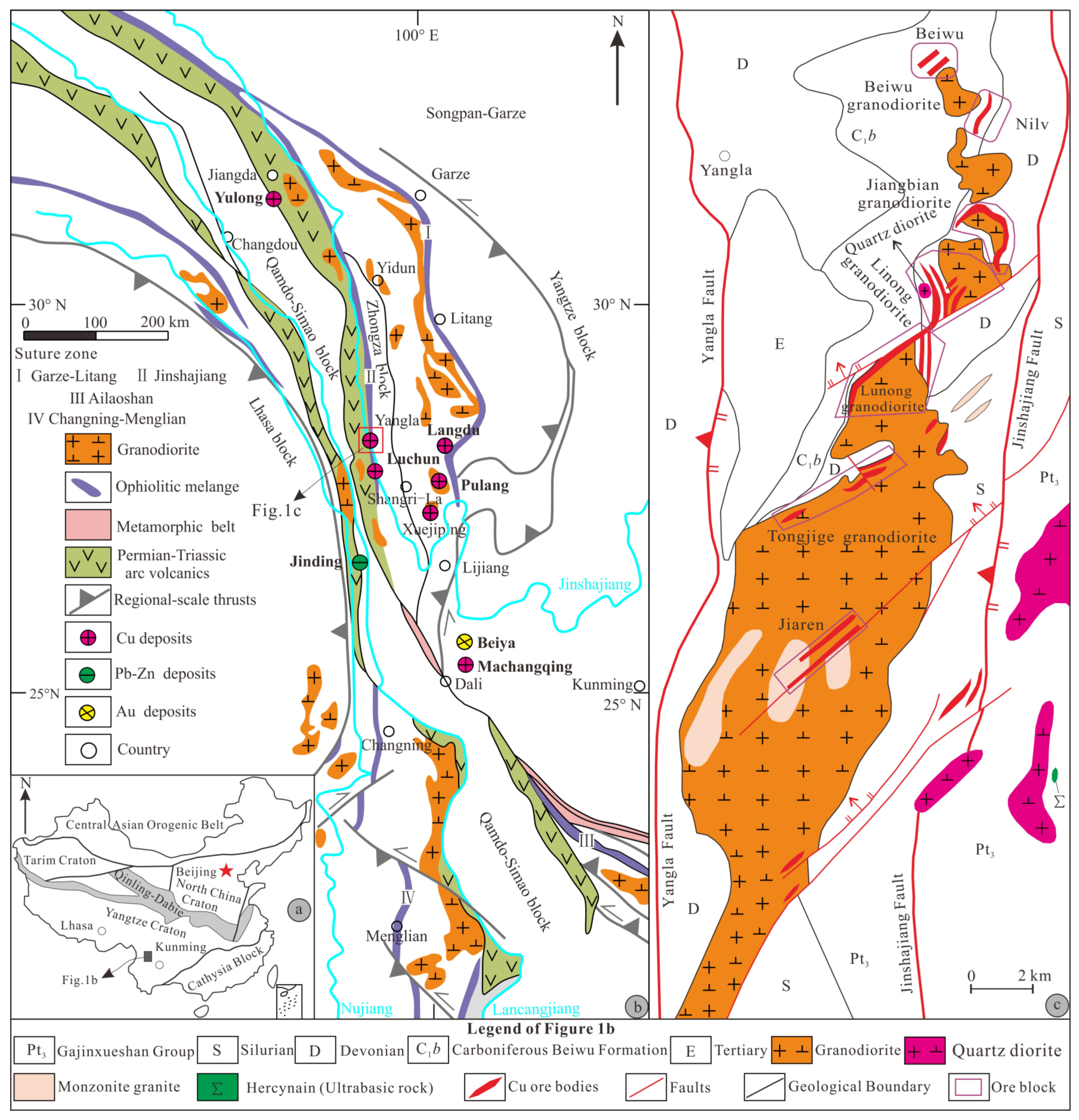

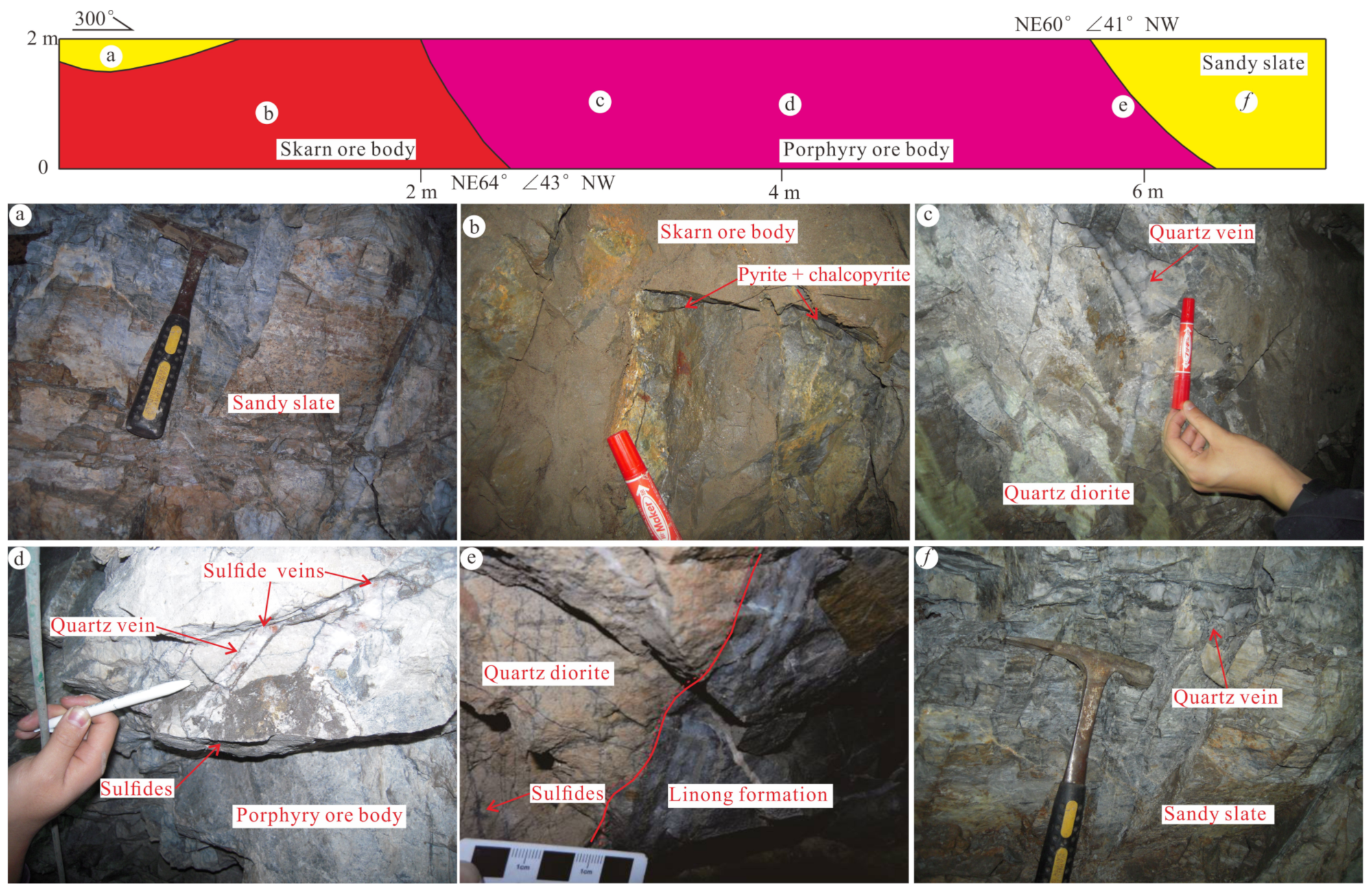
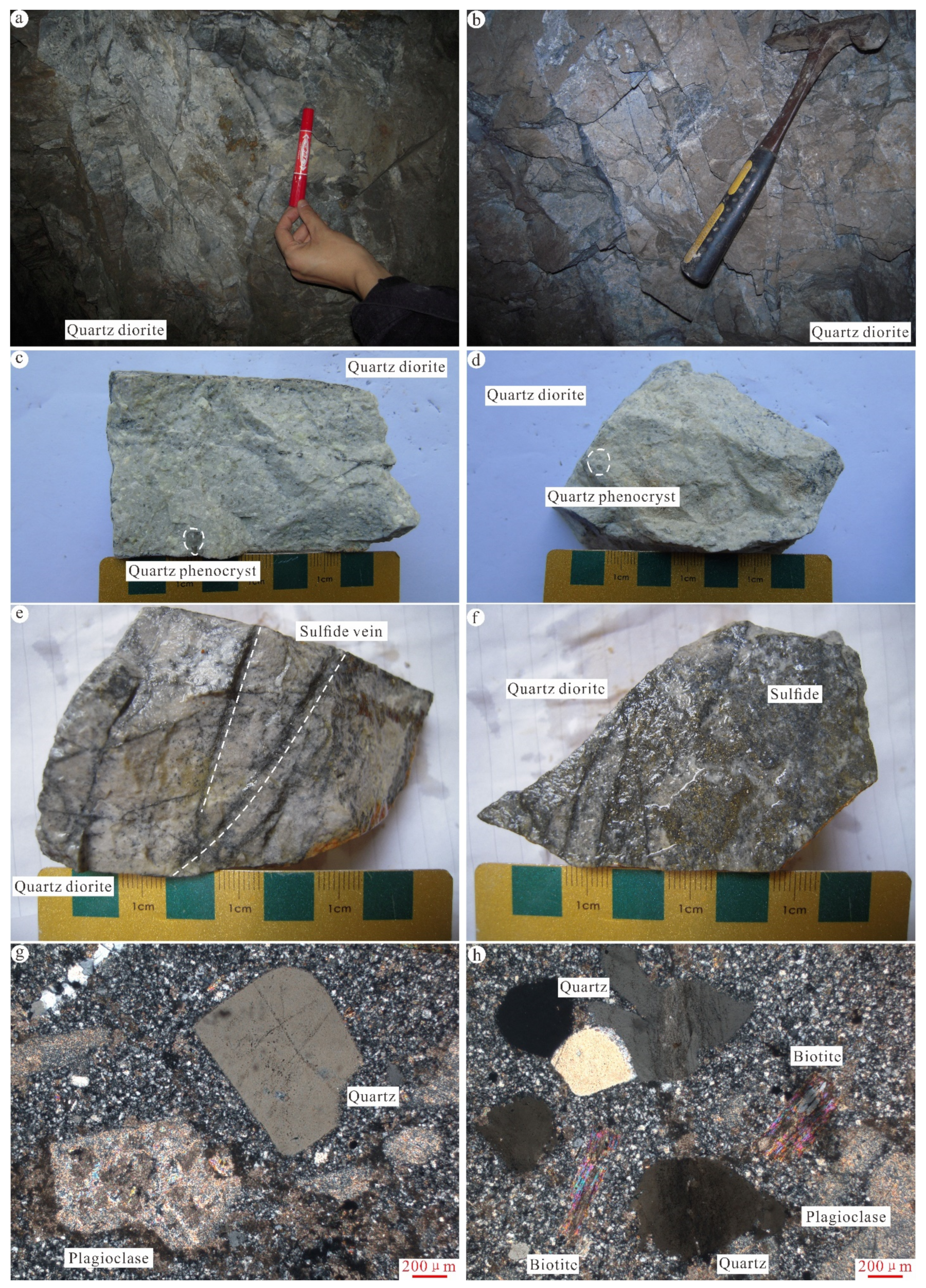



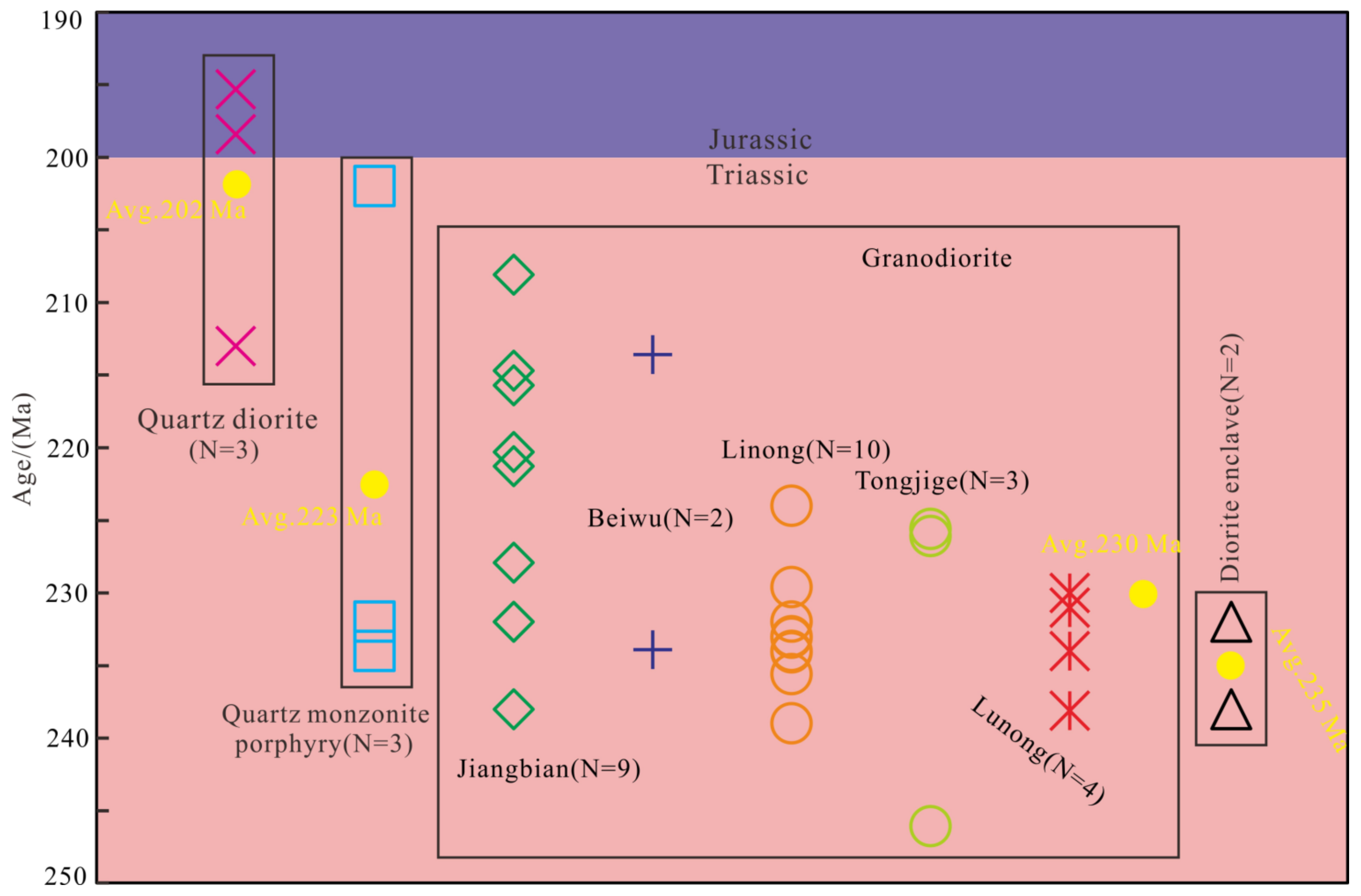
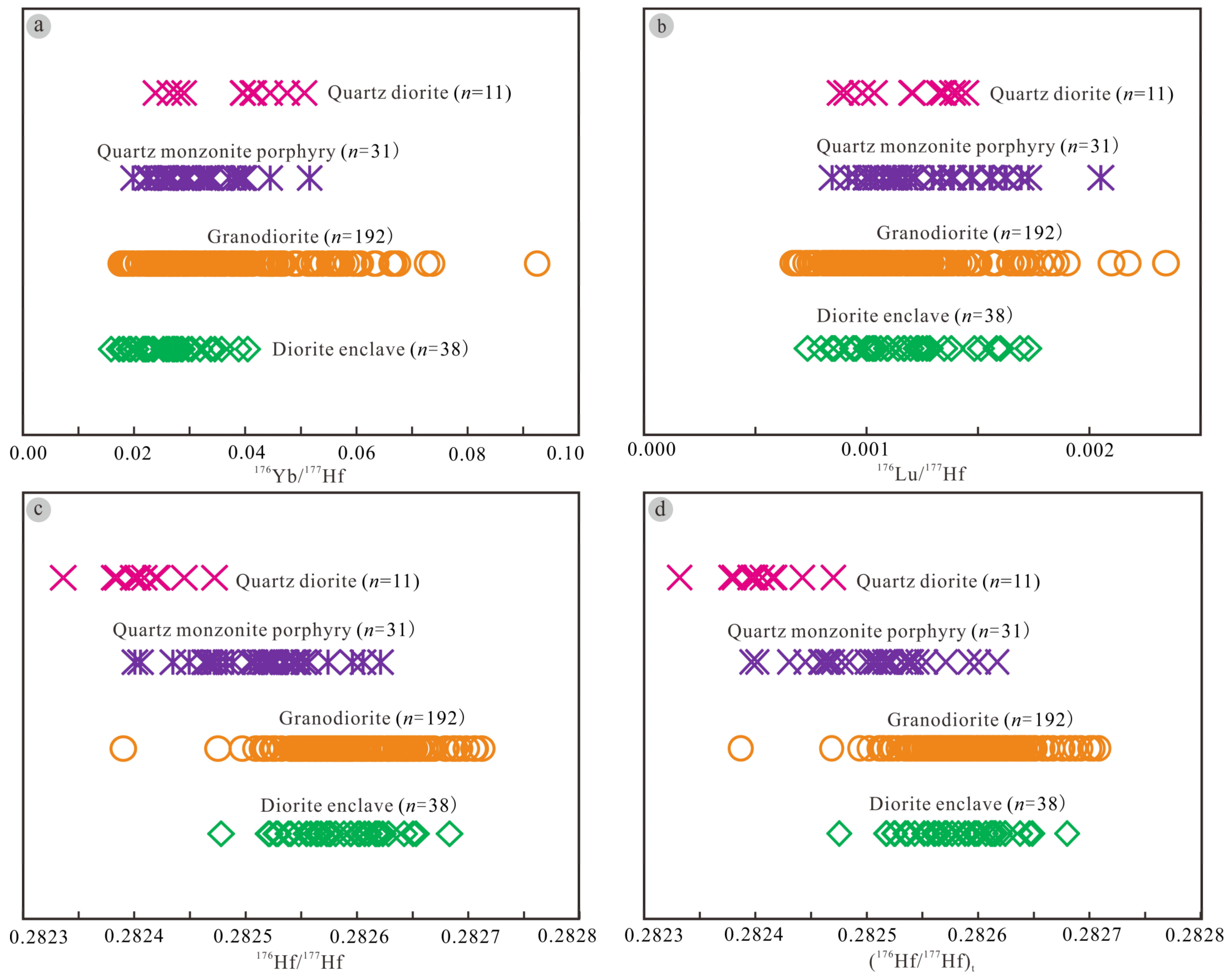
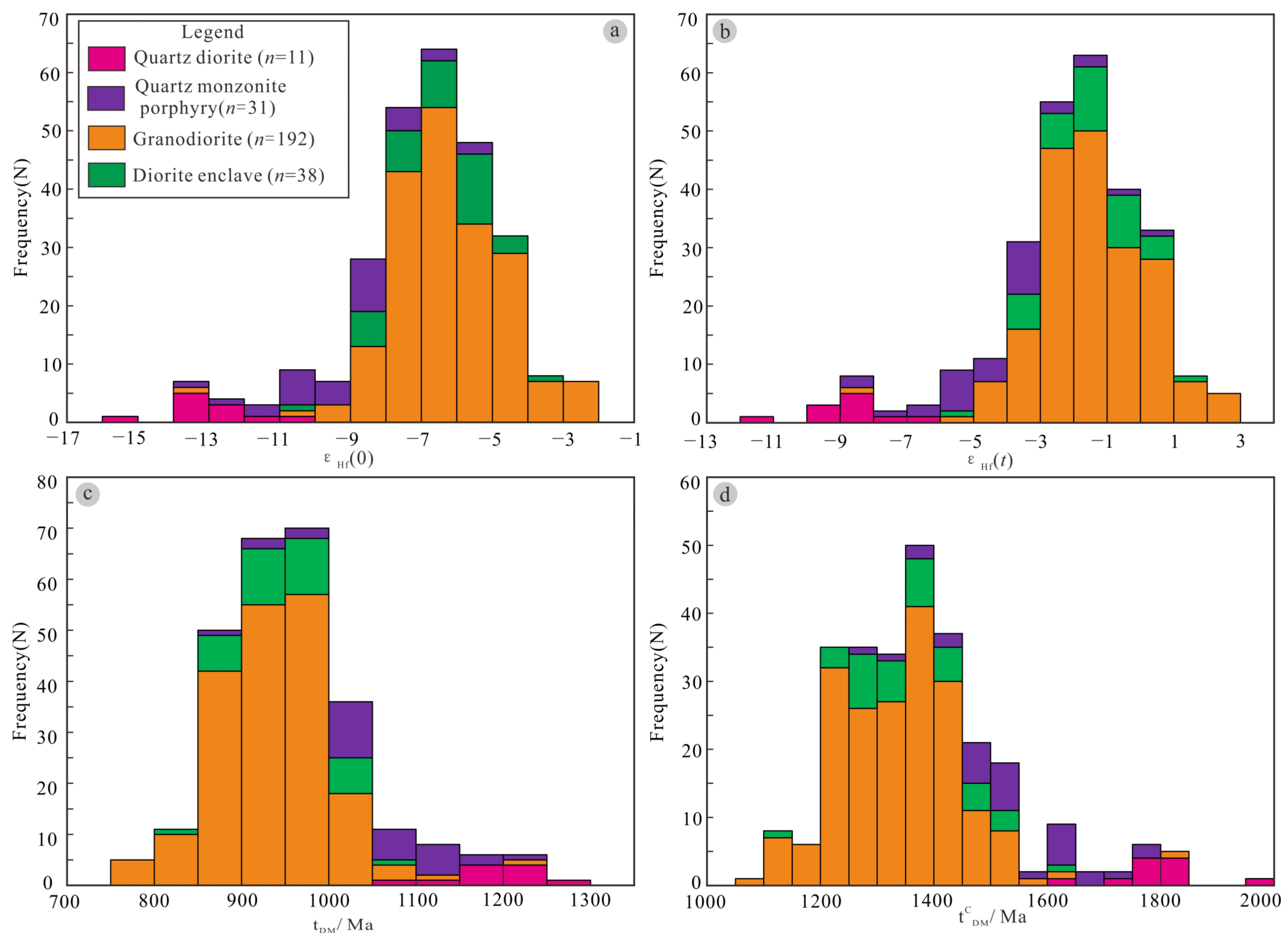
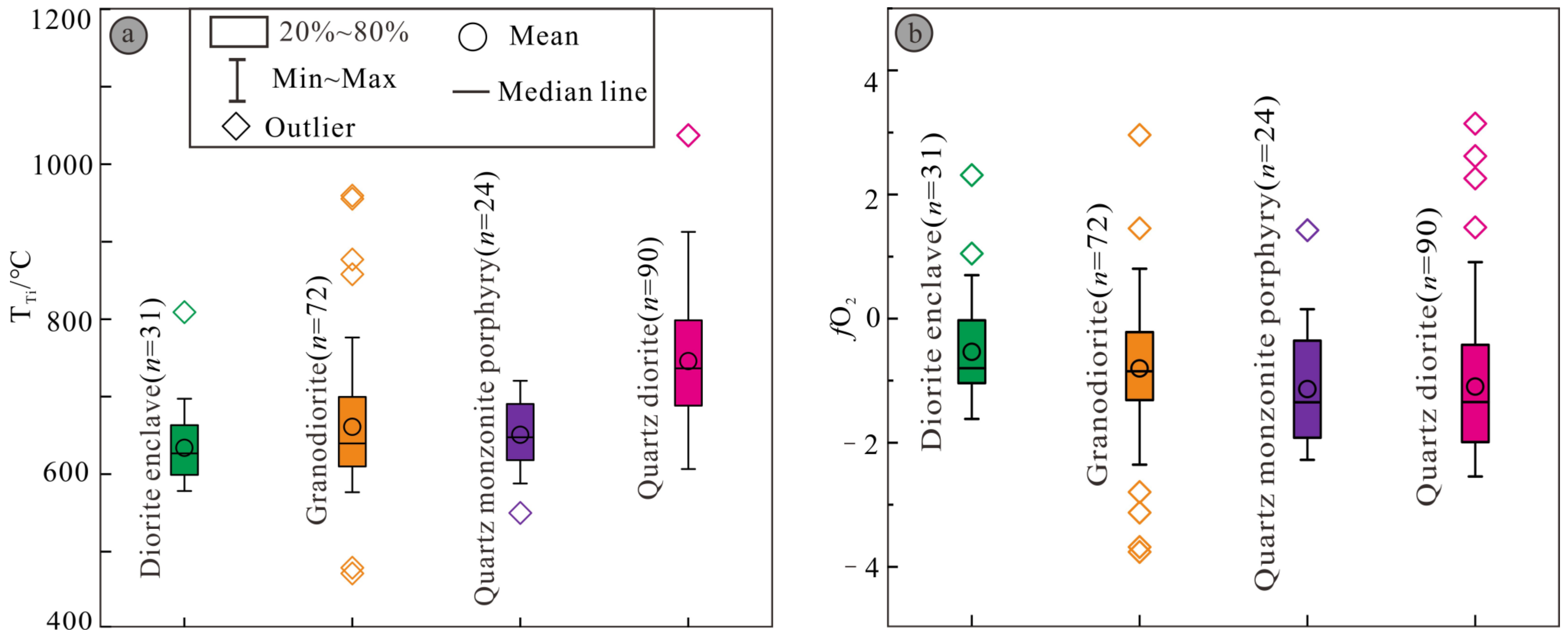
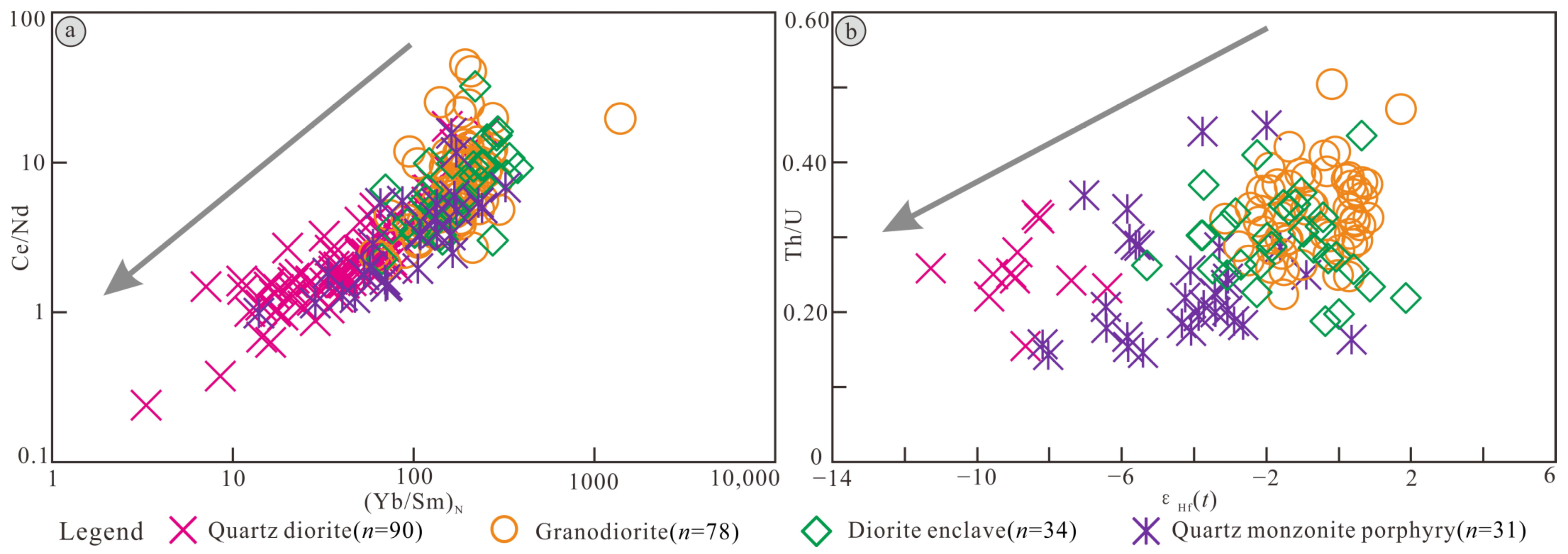
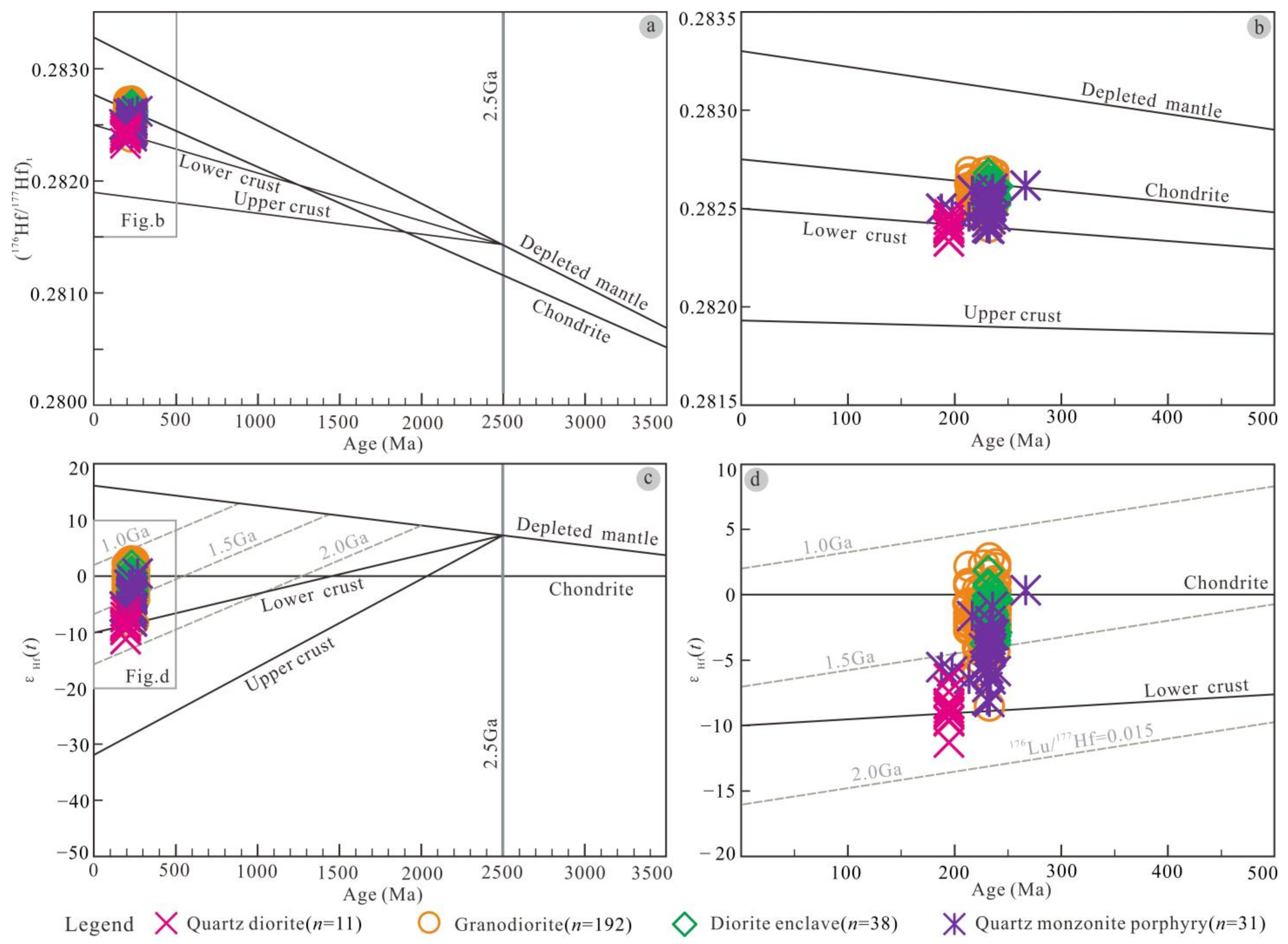

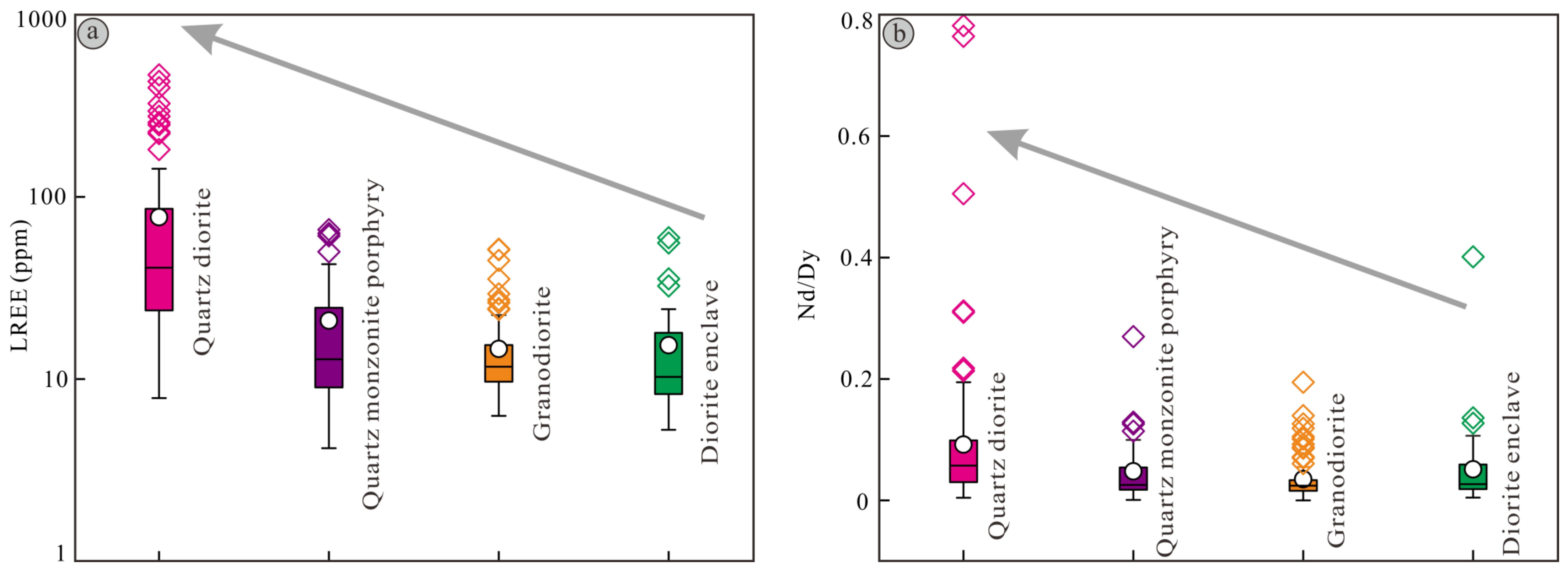

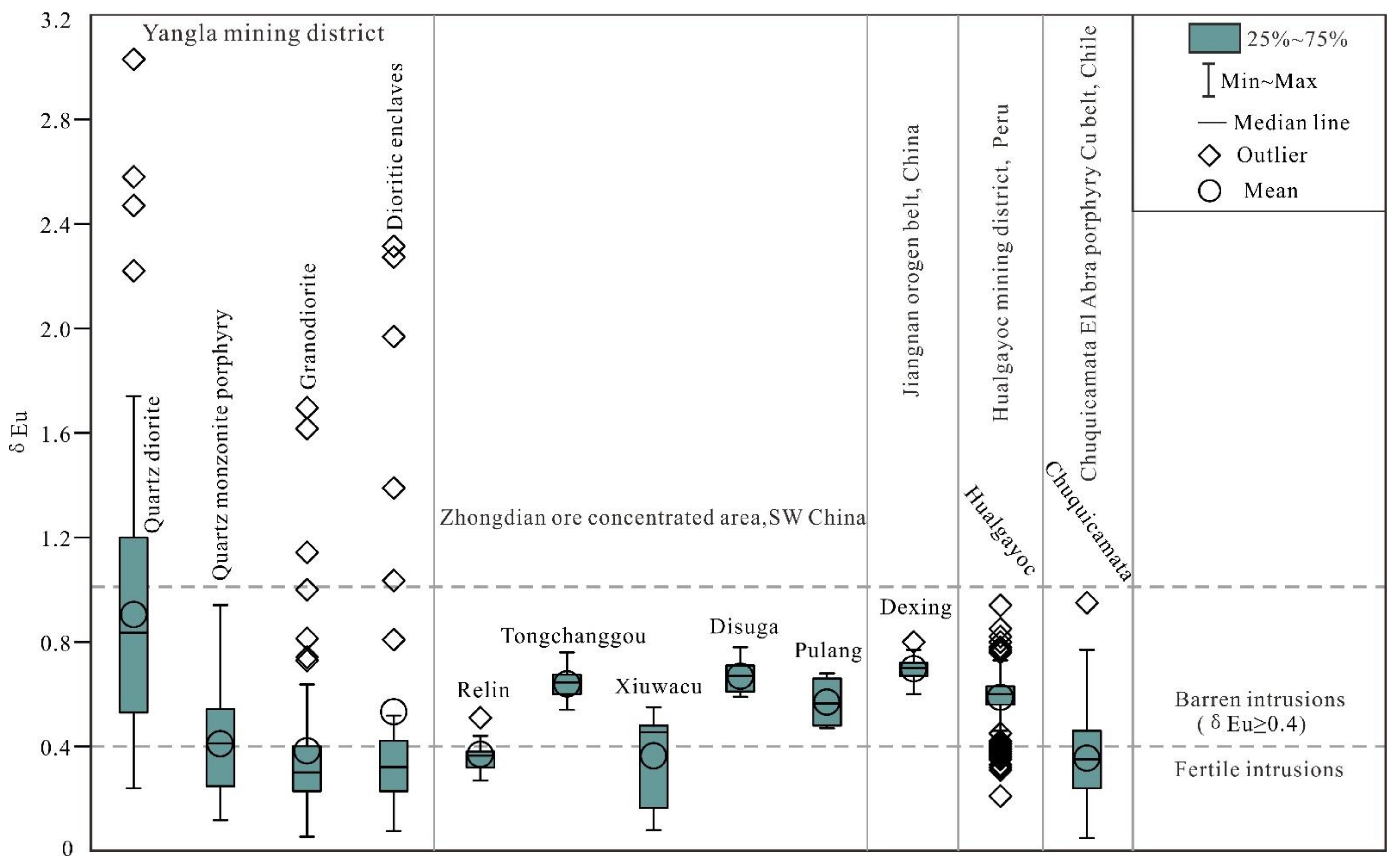
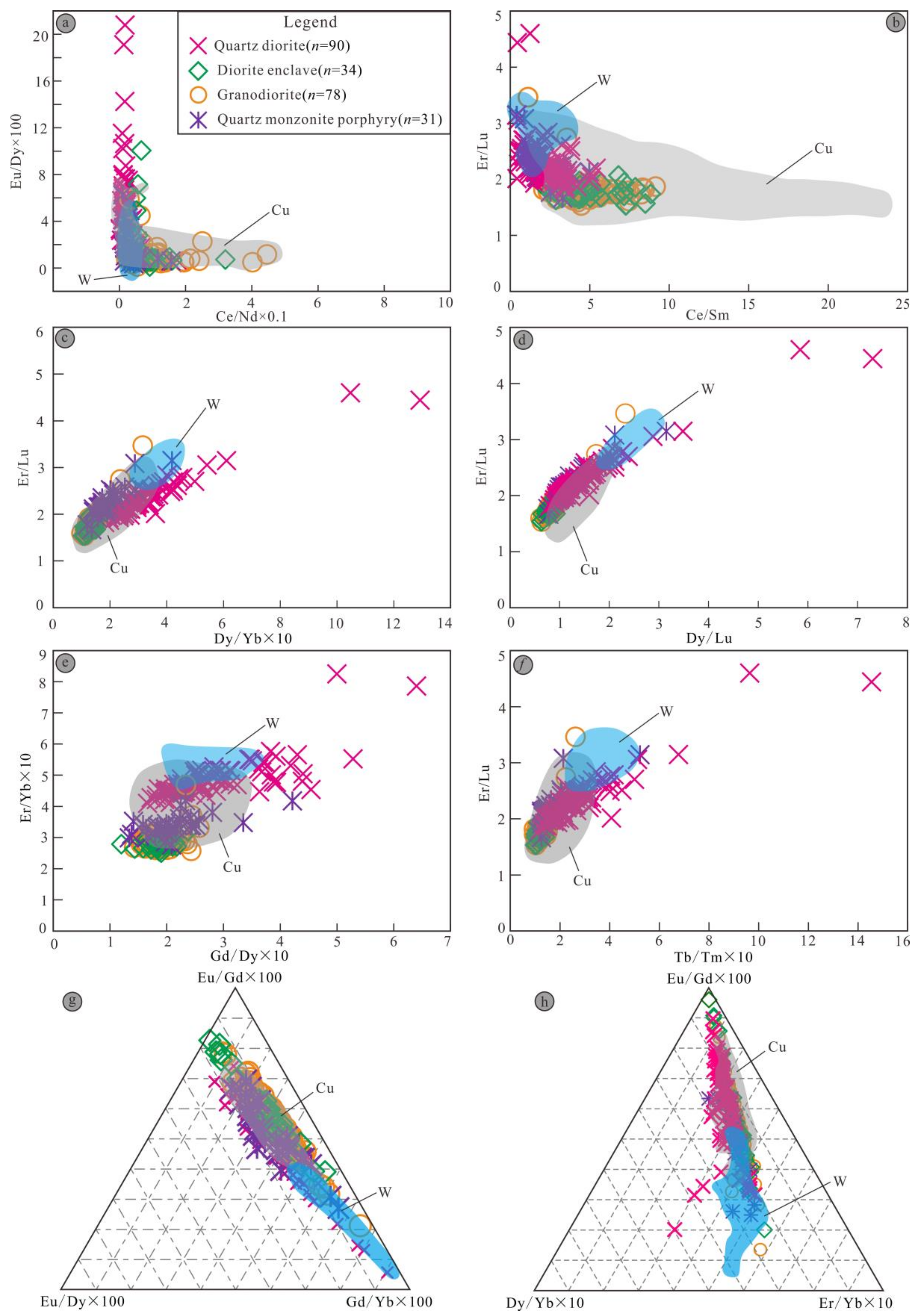
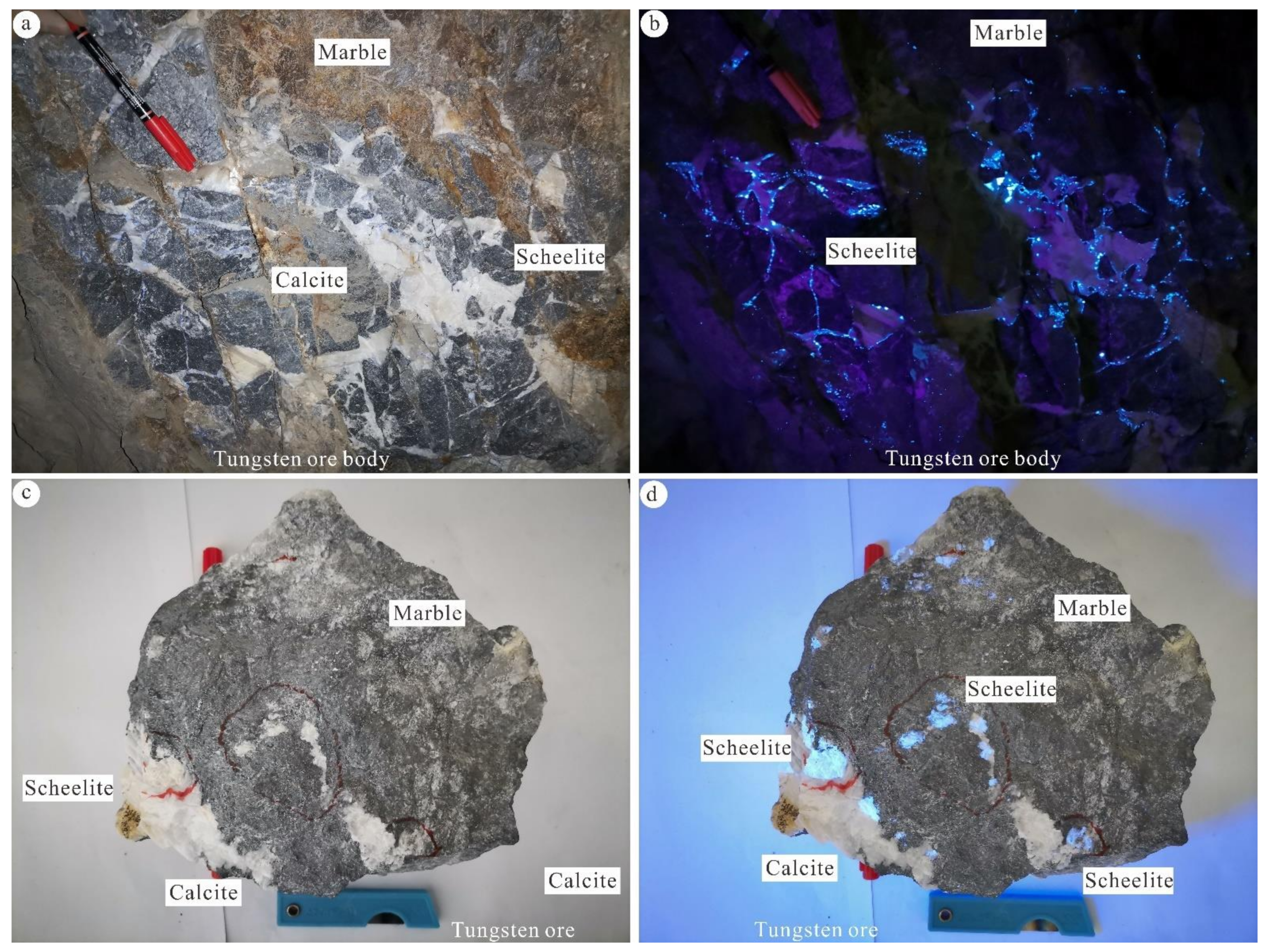
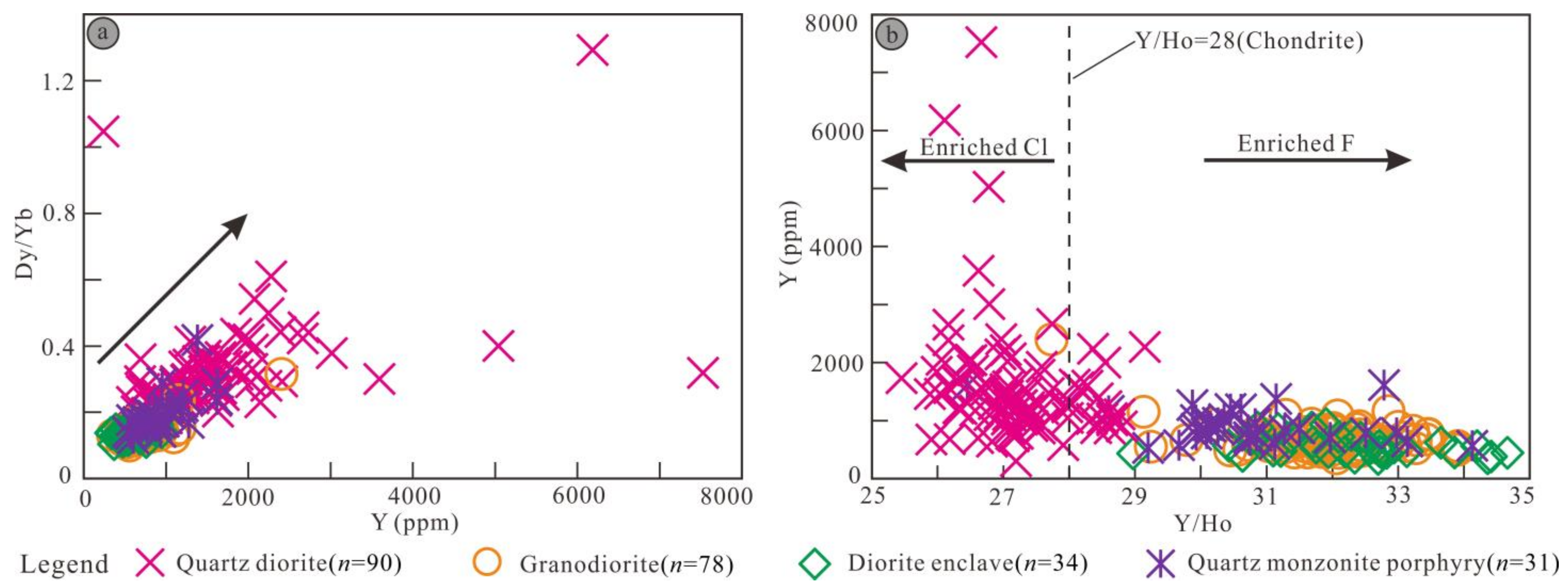
| No. | Ti | Nb | La | Ce | Pr | Nd | Sm | Eu | Gd | Tb | Dy | Ho | Er | Tm | Yb | Lu | Y | Hf | Ta | Pb | Th | U | ΣREE | δEu | δCe | TTi/℃ | ΔFMQ |
|---|---|---|---|---|---|---|---|---|---|---|---|---|---|---|---|---|---|---|---|---|---|---|---|---|---|---|---|
| Sample No. 45-R4 | |||||||||||||||||||||||||||
| Min. | 1.44 | 3.11 | 0.01 | 5.33 | 0.01 | 0.35 | 1.61 | 0.37 | 12.41 | 4.61 | 53.80 | 20.94 | 104.60 | 24.12 | 231.96 | 48.79 | 584 | 7667 | 1.83 | 64 | 210 | 547 | 519 | 0.24 | 1.12 | 616 | −2.54 |
| Max | 19.61 | 19.49 | 35.91 | 99.56 | 13.13 | 70.31 | 52.35 | 19.91 | 159.56 | 38.45 | 302.07 | 79.13 | 310.28 | 70.22 | 671.96 | 146.01 | 2277 | 10400 | 5.95 | 181 | 1147 | 3249 | 1663 | 1.52 | 112.11 | 853 | 2.26 |
| Avg. | 6.61 | 6.50 | 2.43 | 16.24 | 1.34 | 9.53 | 11.63 | 5.15 | 39.73 | 12.24 | 131.19 | 47.10 | 212.36 | 48.31 | 450.90 | 95.87 | 1319 | 8941 | 3.89 | 98 | 620 | 2144 | 1084 | 0.76 | 12.41 | 725 | −1.42 |
| Sample No. 3250-41Lb1 | |||||||||||||||||||||||||||
| Min. | 1.24 | 1.44 | 0.09 | 5.14 | 0.07 | 0.75 | 1.63 | 0.31 | 9.70 | 4.15 | 34.39 | 8.79 | 27.09 | 4.39 | 32.85 | 5.89 | 239 | 6000 | 0.51 | 12 | 77 | 228 | 150 | 0.24 | 1.01 | 606 | −2.45 |
| Max | 26.32 | 23.39 | 81.74 | 176.43 | 22.61 | 109.39 | 38.19 | 51.54 | 122.22 | 33.32 | 353.63 | 134.95 | 604.98 | 133.76 | 1174.65 | 234.10 | 3593 | 9834 | 10.28 | 322 | 8398 | 8358 | 2898 | 3.03 | 20.09 | 887 | 3.14 |
| Avg. | 10.08 | 7.21 | 9.57 | 38.17 | 4.14 | 23.38 | 16.25 | 10.54 | 51.14 | 16.13 | 170.57 | 59.37 | 257.06 | 57.40 | 518.59 | 107.53 | 1583 | 8319 | 4.34 | 115 | 1160 | 2646 | 1340 | 0.99 | 3.05 | 761 | −0.66 |
| Sample No. 3250-41Lb2 | |||||||||||||||||||||||||||
| Min. | 1.51 | 2.19 | 0.01 | 4.06 | 0.04 | 0.50 | 2.72 | 0.60 | 15.34 | 5.71 | 70.05 | 26.34 | 108.91 | 25.30 | 239.91 | 54.07 | 690 | 5058 | 1.95 | 46 | 117 | 776 | 617 | 0.27 | 1.23 | 620 | −2.49 |
| Max | 77.70 | 65.26 | 14.94 | 255.53 | 11.78 | 94.32 | 235.78 | 66.68 | 717.38 | 168.19 | 1120.49 | 282.38 | 1235.61 | 274.17 | 2404.16 | 492.56 | 7529 | 9156 | 13.39 | 467 | 12967 | 12209 | 6218 | 2.58 | 141.31 | 1036 | 0.26 |
| Avg. | 10.45 | 9.47 | 2.43 | 29.36 | 2.13 | 16.31 | 22.24 | 11.49 | 72.85 | 21.08 | 205.51 | 69.05 | 294.53 | 65.37 | 587.53 | 122.81 | 1851 | 8110 | 4.64 | 133 | 1514 | 2695 | 1523 | 0.97 | 10.00 | 748 | −1.20 |
| Intrusions Type | No. | Age/Ma | 176Yb/177Hf | 176Lu/177Hf | 176Hf/177Hf | 2σm | (176Hf/177Hf)t | εHf(0) | εHf(t) | tDM(Ma) | tCDM(Ma) | fLu/Hf | Reference |
|---|---|---|---|---|---|---|---|---|---|---|---|---|---|
| Quartz diorite (45-R4; N = 11) | 1 | 195 | 0.047665 | 0.001408 | 0.282383 | 0.000029 | 0.282378 | −13.77 | −9.66 | 1241 | 1849 | −0.96 | This paper |
| 2 | 195 | 0.044598 | 0.001346 | 0.282420 | 0.000033 | 0.282415 | −12.46 | −8.35 | 1187 | 1766 | −0.96 | ||
| 3 | 195 | 0.050774 | 0.001446 | 0.282403 | 0.000030 | 0.282398 | −13.03 | −8.95 | 1213 | 1803 | −0.96 | ||
| 4 | 195 | 0.027950 | 0.000981 | 0.282404 | 0.000029 | 0.282400 | −13.03 | −8.88 | 1198 | 1799 | −0.97 | ||
| 5 | 195 | 0.041369 | 0.001387 | 0.282400 | 0.000030 | 0.282395 | −13.17 | −9.05 | 1217 | 1812 | -0.96 | ||
| 6 | 195 | 0.039769 | 0.001327 | 0.282421 | 0.000023 | 0.282417 | −12.40 | −8.28 | 1184 | 1762 | −0.96 | ||
| 7 | 195 | 0.039664 | 0.001204 | 0.282385 | 0.000035 | 0.282381 | −13.67 | −9.55 | 1231 | 1842 | −0.96 | ||
| 8 | 195 | 0.029164 | 0.001035 | 0.282410 | 0.000027 | 0.282406 | −12.81 | −8.66 | 1191 | 1785 | −0.97 | ||
| 9 | 195 | 0.026465 | 0.000911 | 0.282473 | 0.000029 | 0.282470 | −10.58 | −6.40 | 1099 | 1643 | −0.97 | ||
| 10 | 195 | 0.024001 | 0.000881 | 0.282446 | 0.000025 | 0.282442 | −11.54 | −7.39 | 1136 | 1704 | −0.97 | ||
| 11 | 195 | 0.041744 | 0.001207 | 0.282337 | 0.000034 | 0.282332 | −15.39 | −11.28 | 1299 | 1950 | −0.96 | ||
| Min. | 195 | 0.024001 | 0.000881 | 0.282337 | 0.000023 | 0.282332 | −15.39 | −11.28 | 1099 | 1643 | −0.97 | ||
| Max. | 195 | 0.050774 | 0.001446 | 0.282473 | 0.000035 | 0.282470 | −10.58 | −6.40 | 1299 | 1950 | −0.96 | ||
| Avg. | 195 | 0.037560 | 0.001194 | 0.282407 | 0.000029 | 0.282403 | −12.90 | −8.77 | 1200 | 1792 | −0.96 | ||
| Quartz monzonite porphyry (N = 31) | Min. | 188 | 0.019956 | 0.000844 | 0.282401 | 0.000021 | 0.282396 | −13.12 | −8.18 | 894 | 1268 | −0.97 | [3] |
| Max. | 267 | 0.051689 | 0.002051 | 0.282622 | 0.000047 | 0.282617 | −5.31 | 0.37 | 1207 | 1785 | −0.94 | ||
| Avg. | 230 | 0.031792 | 0.001297 | 0.282513 | 0.000027 | 0.282508 | −9.15 | −4.29 | 1054 | 1536 | −0.96 | ||
| Granodiorite (N = 192) | Min. | 213 | 0.017773 | 0.000672 | 0.282391 | 0.000009 | 0.282387 | −13.47 | −8.50 | 767 | 1082 | −0.98 | [2,3,4,5] |
| Max. | 239 | 0.092584 | 0.002346 | 0.282713 | 0.000038 | 0.282708 | −2.09 | 2.86 | 1217 | 1805 | −0.93 | ||
| Avg. | 230 | 0.036373 | 0.001163 | 0.282595 | 0.000021 | 0.282590 | −6.26 | −1.43 | 934 | 1337 | −0.97 | ||
| Dioritic enclaves (N = 38) | Min. | 229 | 0.016020 | 0.000735 | 0.282479 | 0.000019 | 0.282475 | −10.37 | −5.30 | 806 | 1147 | −0.98 | [3] |
| Max. | 241 | 0.040573 | 0.001727 | 0.282684 | 0.000027 | 0.282680 | −3.11 | 1.87 | 1089 | 1606 | −0.95 | ||
| Avg. | 235 | 0.025544 | 0.001159 | 0.282587 | 0.000023 | 0.282582 | −6.53 | −1.54 | 946 | 1366 | −0.97 |
| Intrusions Type | Minerals/Methods | Age/Ma | References |
|---|---|---|---|
| Quartz diorite | Zircon/U-Pb | 195.3 ± 6.4, 198.40 ± 8.6, and 213 ± 15 | [14] |
| Quartz monzonite porphyry | Zircon/U-Pb | 232 ± 1.1 and 234.0 ± 1.2. | [3] |
| Whole-rock/Rb-Sr | 202 | [33] | |
| Beiwu granodiorite | Zircon/U-Pb | 213.6 ± 6.9 and 233.9 ± 1.4 | [2,4] |
| Jiangbian granodiorite | Zircon/U-Pb | 227.9 ± 5.1, 232.0 ± 0.5, 232.0 ± 0.9, 238.0 ± 0.5, 208.09 ± 0.46, 215.7 ± 0.63, 221.28 ± 1.0, 220.3 ± 1.3, and 214.7 ± 0.56. | [3,4,6] |
| Linong granodiorite | Zircon/U-Pb | 239.0 ± 5.7, 229.6 ± 4.4, 233.1 ± 1.4, 234.1 ± 1.2, 235.6 ± 1.2, 232.0 ± 0.9, 233.0 ± 0.9Ma, 224 ± 0.7, 232 ± 1.1, and 234 ± 1.2 | [2,3,4,6] |
| Lunong granodiorite | Zircon/U-Pb | 238.1 ± 5.3, 231.0 ± 1.6, 230 ± 1.9, and 234 ± 0.8. | [2,3,4] |
| Tongjige granodiorite | Zircon/U-Pb | 246.1 ± 3.1, 225.6 ± 1.3, and 226.1 ± 3.3 | [5,35] |
| Dioritic enclaves | Zircon/U-Pb | 232 ± 0.9 and 238 ± 0.5. | [3] |
| Sample No. | Cu/ppm | W/ppm | Reference |
|---|---|---|---|
| 3250-41-3 | 5209 | 1103 | [32] |
| 3250-41-4 | 12,170 | 295 | |
| 3250-41-5 | 2019 | 79 |
Publisher’s Note: MDPI stays neutral with regard to jurisdictional claims in published maps and institutional affiliations. |
© 2022 by the authors. Licensee MDPI, Basel, Switzerland. This article is an open access article distributed under the terms and conditions of the Creative Commons Attribution (CC BY) license (https://creativecommons.org/licenses/by/4.0/).
Share and Cite
Wang, X.; Li, B.; Tang, G.; Lei, Z.; Chang, H. Petrogenesis and Metallogenesis of Granitoids in the Yangla Cu-W Polymetallic Deposit, Southwest China: Evidence from Zircon Trace Elements and Hf Isotope. Minerals 2022, 12, 1427. https://doi.org/10.3390/min12111427
Wang X, Li B, Tang G, Lei Z, Chang H. Petrogenesis and Metallogenesis of Granitoids in the Yangla Cu-W Polymetallic Deposit, Southwest China: Evidence from Zircon Trace Elements and Hf Isotope. Minerals. 2022; 12(11):1427. https://doi.org/10.3390/min12111427
Chicago/Turabian StyleWang, Xinfu, Bo Li, Guo Tang, Zhen Lei, and He Chang. 2022. "Petrogenesis and Metallogenesis of Granitoids in the Yangla Cu-W Polymetallic Deposit, Southwest China: Evidence from Zircon Trace Elements and Hf Isotope" Minerals 12, no. 11: 1427. https://doi.org/10.3390/min12111427
APA StyleWang, X., Li, B., Tang, G., Lei, Z., & Chang, H. (2022). Petrogenesis and Metallogenesis of Granitoids in the Yangla Cu-W Polymetallic Deposit, Southwest China: Evidence from Zircon Trace Elements and Hf Isotope. Minerals, 12(11), 1427. https://doi.org/10.3390/min12111427









